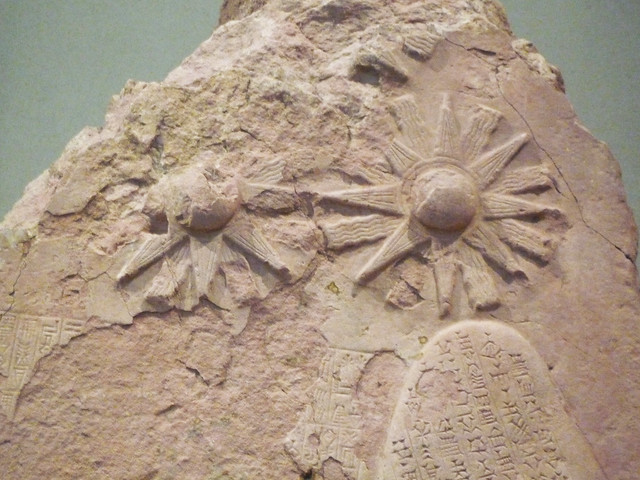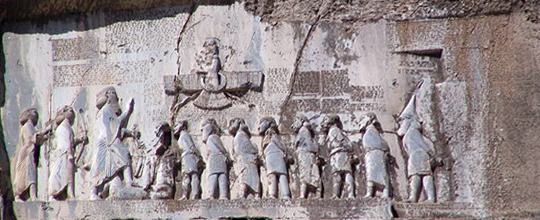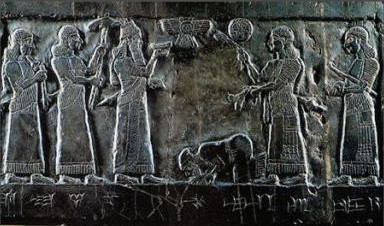Dagan the First God of the Semitic People
Dagan rose from being an almost unknown god amongst the Great Gods of Sumeria, to becoming the predominant god of the Semitic Akkadians. Dagan rose to power by victory. Dagan assisted Sargon and especially Sargon's Grandchild Naram-Sin, to defeat their enemies, and enable their Akkadian empire into a position of world power. In the great Stele of Naram-Sin, Naram-Sin is seen looking up to what the underlying text calls the great weapon of Dagan.

The text reads; "Naram-Sin slew the Arman and Ibla with the weapon of the God Dagan, who aggrandize his region". Take note of Naram-Sin in the stele above as he gazes upward at this great weapon. The weapon is a four wheel chariot with the two wheels on one side extending outside of the relief. If you look even closer you will observe that at the end of each axle are two wheels, one inside the other.

This is exactly what the prophet Ezekiel saw in the famous appearance of Ezekiel's chariot. Ezekiel 1: 16 states; "The appearance of wheels.... and the four had one likeness and their work was as it were a wheel within a wheel". Dagan, the Sumerian word, and later Yahweh, the Akkadian/Hebrew word were the same god.

The photo above taken from the NASA images, web page below, shows what appears as a space vehicle with a wheel within a wheel. Image is 1/3 up on the right edge. I apologize for the fact that NASA has taken down the original web site, and I can no longer show this web page. The image above appears to be well over 200 km across.
The prophet Daniel saw these chariots as, "the chariots of the gods". The prophet Elisha was surrounded by "chariots of fire." They were depicted throughout the regions of Sumeria, Akkadia, Babylon, Persia and Assyria , for several thousand years.



An art form of an ancient "Chariot of the Gods" depicted below, was drawn or engraved on nearly every early stele from the time of Sumeria to the Persians covering a period of several thousand years. In most cases the images carried one or more personnel, had wings to indicate flight, and also indicated a wheel within a wheel of eight spokes. Take special notice, the eight spoked wheels on the stele of Naram-Sin and the chariot below are drawn exactly the same. Drawn just behind the figure with the bow.

The Sumerian relief below shows a Great God riding a four wheeled chariot, with the ability of flight, as shown by the flying sphinx. Just above the chariot is an illustration that demonstrates that the chariots has the ability to launch or throw lightning bolts. Also the lion seems to be throwing destructive flames out of it's mouth. These chariots of the Gods were often an integral part of the wars of man.
Dagan rose from being an almost unknown god amongst the Great Gods of Sumeria, to becoming the predominant god of the Semitic Akkadians. Dagan rose to power by victory. Dagan assisted Sargon and especially Sargon's Grandchild Naram-Sin, to defeat their enemies, and enable their Akkadian empire into a position of world power. In the great Stele of Naram-Sin, Naram-Sin is seen looking up to what the underlying text calls the great weapon of Dagan.

The text reads; "Naram-Sin slew the Arman and Ibla with the weapon of the God Dagan, who aggrandize his region". Take note of Naram-Sin in the stele above as he gazes upward at this great weapon. The weapon is a four wheel chariot with the two wheels on one side extending outside of the relief. If you look even closer you will observe that at the end of each axle are two wheels, one inside the other.

This is exactly what the prophet Ezekiel saw in the famous appearance of Ezekiel's chariot. Ezekiel 1: 16 states; "The appearance of wheels.... and the four had one likeness and their work was as it were a wheel within a wheel". Dagan, the Sumerian word, and later Yahweh, the Akkadian/Hebrew word were the same god.

The photo above taken from the NASA images, web page below, shows what appears as a space vehicle with a wheel within a wheel. Image is 1/3 up on the right edge. I apologize for the fact that NASA has taken down the original web site, and I can no longer show this web page. The image above appears to be well over 200 km across.
The prophet Daniel saw these chariots as, "the chariots of the gods". The prophet Elisha was surrounded by "chariots of fire." They were depicted throughout the regions of Sumeria, Akkadia, Babylon, Persia and Assyria , for several thousand years.
Again, above we see the same Anunnaki throne/chariot leading an army to victory. This relief is in Persia, at the famous site of Behistun, depicting Darius the Great's victories, after the death of Cyrus. It appears the Anunnaki took an active part in the wars of man.
Another great example of this interference by the Anunnaki in the wars of man is when the Assyrians defeated the 10 tribes of Israel and commemorated that event by raising the famous Black Stele, seen below. In the middle bottom of the stele is Jehu, the King of Israel, who is seen in bonds, and above this figure is the Great weapon of the Anu, the chariot of the Gods of Anu, which assisted in Jehu's defeat.
In the figure above the Anunnaki are seen here on either side of the tree of life, with their Chariot of the Gods above them. Many historians have determined that this throne chariot, seen above the tree of life, is really an ancient Sun God, but when has a Sun God taken two hitchhikers, on a ride. This depiction done by the Sumerians of a chariot of the Gods was drawn from what they observed, not some mythological Sun God. The Anunnaki on either side of a tree of life, with the throne /chariot above them , is repeated over and over in their reliefs.
An art form of an ancient "Chariot of the Gods" depicted below, was drawn or engraved on nearly every early stele from the time of Sumeria to the Persians covering a period of several thousand years. In most cases the images carried one or more personnel, had wings to indicate flight, and also indicated a wheel within a wheel of eight spokes. Take special notice, the eight spoked wheels on the stele of Naram-Sin and the chariot below are drawn exactly the same. Drawn just behind the figure with the bow.

The Sumerian relief below shows a Great God riding a four wheeled chariot, with the ability of flight, as shown by the flying sphinx. Just above the chariot is an illustration that demonstrates that the chariots has the ability to launch or throw lightning bolts. Also the lion seems to be throwing destructive flames out of it's mouth. These chariots of the Gods were often an integral part of the wars of man.
Dagan changes his name to Yahweh
In ancient times it was customary to have the names of major cities, and the names of Kings reflect the Gods they worshipped. The word for this is theophoric names. In the royal house of Larsa, their king was named Nur-Dagan, or in the royal house of Isin, 2 kings were named after Dagan, Iddin-Dagan, and Isme-Dagan, the later even went further, to call himself the son of Dagan.
In the Bible the son of King David is named Baalya or Bealiah which means Baal is Ya or Yehovah is Baal. Baal being named the son of Dagan and who were both worshipped by the people throughout the land of Canaan. Ya is an abbreviation of Yehovah. This to many bible scholars is a paradox, in linking Dagan and Ya, but it points to the fact that both are the same person.
The name Israel contains the letters of the supreme god of the Egyptians "RA", and the Supreme God of the land of Canaan "El", signifying that they were part of the Hebrews past and present worship.
In the Bible the son of King David is named Baalya or Bealiah which means Baal is Ya or Yehovah is Baal. Baal being named the son of Dagan and who were both worshipped by the people throughout the land of Canaan. Ya is an abbreviation of Yehovah. This to many bible scholars is a paradox, in linking Dagan and Ya, but it points to the fact that both are the same person.
The name Israel contains the letters of the supreme god of the Egyptians "RA", and the Supreme God of the land of Canaan "El", signifying that they were part of the Hebrews past and present worship.
In early Mesopotamia, two Kings, Yahdun-Lim and Yasmah-Addu both show the recognizable theophoric connection to Yehovah, and both were exclusive worshippers of Dagan. One calling himself the Governor of Dagan. Yahdum-Lim , the King of Mari, in present day Syria, is quoted in cuneiform text recovered from the diggings in Mari, “Yahdum-Lim King of Mari, The God Dagan proclaimed my kingship, who controls the banks of the Euphrates, and gave me a mighty weapon that fells my royal enemies.”
Again Dagan and the use of his mighty weapon, that destroys the armies of man, is mentioned. This was the very same weapon used with Naram-Sin, for his territorial expansion. Mari, Yadhun-Lim's capital, has extreme importance today, in that of nearly 25,000 cuneiform texts, were unearthed there.
Again Dagan and the use of his mighty weapon, that destroys the armies of man, is mentioned. This was the very same weapon used with Naram-Sin, for his territorial expansion. Mari, Yadhun-Lim's capital, has extreme importance today, in that of nearly 25,000 cuneiform texts, were unearthed there.
Yasmah-Addu, was one of the 2 sons of the King of Assyria, the other being Ishme-Dagan.
Yasmah-Addu ruled in Mari, while his brother and Father ruled the other 2/3rds of the empire. Dagan as their God, is recognizable in their names, along with the use of Ya, and a son of Dagan, named Addu.
A neighbouring city to Mari, in Syria is Ebla, which in the mid 60's was unearthed by an Italian archaeologist by the name of Pettinato. In his diggings he discovers some 20,000 cuneiform texts.

Tablets discovered at Ebla, which is in northern Syria.
Some of which would drastically change the image of the early near east. Pettinato discovers the divine name Ya, later to emerge as YHWH or Yahweh. The Sumerian name was Dinger Ya-ra-mu, translated God Ya-ra-mu. He also makes a discovery that the letters “EL” are being changed to “YA” at this time in history. EL being the senior deity of the Canaanites to Ya the God of Moses. Pettinato notices that in the translation of the word Mikail, that those now living in Ebla have translated the spelling to Mikaya. For some reason there is a shift in spelling and pronunciation to “YA” in these cities that worship Dagan. It would seem that with the change of worship to a new God, the spelling names of cities and important locations also has to be changed. Both of these cities along with Dagan's major temple at nearby Tuttul were major centres of worship for the God Dagan.
Tablets discovered at Ebla, which is in northern Syria.
Some of which would drastically change the image of the early near east. Pettinato discovers the divine name Ya, later to emerge as YHWH or Yahweh. The Sumerian name was Dinger Ya-ra-mu, translated God Ya-ra-mu. He also makes a discovery that the letters “EL” are being changed to “YA” at this time in history. EL being the senior deity of the Canaanites to Ya the God of Moses. Pettinato notices that in the translation of the word Mikail, that those now living in Ebla have translated the spelling to Mikaya. For some reason there is a shift in spelling and pronunciation to “YA” in these cities that worship Dagan. It would seem that with the change of worship to a new God, the spelling names of cities and important locations also has to be changed. Both of these cities along with Dagan's major temple at nearby Tuttul were major centres of worship for the God Dagan.
Fig10. The above coin from the 4th century BC, is from the location of modern day Gaza, honouring their God Yahu. Many believe, these are the people, the Egyptians referred to as the “Sea People”, descendants of early Phoenicians, whose water God was named, Yam-Nahar. Notice the cherub winged throne chariot, that is also evident in Ezekiel's vision of Yahweh's throne chariot.
The texts below are from the three tablets of Sin-mubalit, Hammurabi's father, translated by Deilitzsch in 1902. This text predates Abraham.
The question is why would Dagan change his name to Yahweh? The answer to that is quite simple. When a God is declaring himself, as Dagan had, the “Creator of Heaven and Earth”, it is difficult for him to convince his seed of that when, Sargon and the Kingdom of Agade, had been completely wiped out. Not exactly an all powerful, all omnipotent, all knowing God. Dagan will take time to rebuild his seed and to reestablish his earthly kingdom, but he would not use the name Dagan. If Dagan used his name, it would enable his seed to look back and examine at his past failures. Nearly 2 millennium later his Semitic kingdom is led by another strong central figure very similar to Sargon. His name being Moses.
The underlying question in all of this, is why? Why is there this aggressive, confrontational attitude between Dagan and Enlil, the head of the Anunnaki Council? The answer is one of the oldest stories known to man. Both Dagan and Enlil are having relations with the same women. According to Sumerian text both are married to the same women, but are the Sumerians really aware of the fact that one is married and the other is having an affair. Exactly which one is married, has brought some confusion to this ancient story, but from this, centuries of conflict arise. To most modern experts studying ancient Sumeria, this is quite a paradox, of having both Gods, being married to Salas. Salas is said to be married to the Storm God, who is Enlil in Sumerian text, but also to Dagan, but if we look closely at Enlil, he already has a consort, Ninlil, so it appears that Dagan is the god on the short end of the stick. This all adds testimony and credence to Dagan's extremely aggressive nature towards the people of the Sumer valley, some of which are the direct seed of Enlil. Love and hate, the oldest game on earth.
For further reading;
Original images from Nasa;
http://www.youtube.com/watch?feature=player_embedded&v=Aq8vuTQjSfk
http://trueancienthistory.blogspot.ca/2013/05/germany-in-ww-2-builds-chariot-of-gods.html
For further reading;
Original images from Nasa;
http://www.youtube.com/watch?feature=player_embedded&v=Aq8vuTQjSfk
http://trueancienthistory.blogspot.ca/2013/05/germany-in-ww-2-builds-chariot-of-gods.html



No comments:
Post a Comment